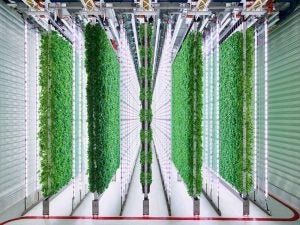Walmart just announced a new venture into indoor vertical farming, with its goal being to provide fresh produce to their retail stores.
Walmart signed an agreement to invest in Plenty, an indoor vertical farming company, as part of their $400M Series E funding round subject to a regulatory approval. Walmart and Plenty will work to provide fresh produce year-round to customers. According to the press release, Walmart is the first large U.S. retailer to significantly invest in vertical farming. The long-term commercial agreement allows Walmart to source Plenty’s leafy greens for all its California stores from Plenty’s Compton farm beginning later this year.
The company’s indoor farming architecture differs from greenhouses and other indoor farms, combining engineering, software, and sustainable crop science to grow multiple crops on one platform, at what they say is unprecedented speed. Backed by a large U.S patent portfolio, Plenty’s proprietary tech “meaningfully improves on traditional agriculture’s use of water and land.”
However, vertical farming is not the be-all and end-all solution to everything facing the industry, according to Allison Kopf CEO of Agrilyst, an intelligence platform for indoor farms. Vertical farming is capital intensive, rent dependent, and not suitable for all types of crops. But it can be a tool to help feed a growing population. The agriculture industry is becoming more innovative and more technology-focused every day.

This is not Walmart’s first venture into the agriculture industry. They originally started out by entering into the dairy industry when they opened their own milk processing plant. A year later, they got into the beef industry, developing an end-to-end supply chain for Angus beef.
Walmart and Plenty claim that this “farming technology platform delivers pesticide-free produce that tastes like it was picked fresh from the garden, all year long.” Plenty is currently growing different lettuce varieties, including kale, arugula and spring mix among others.


